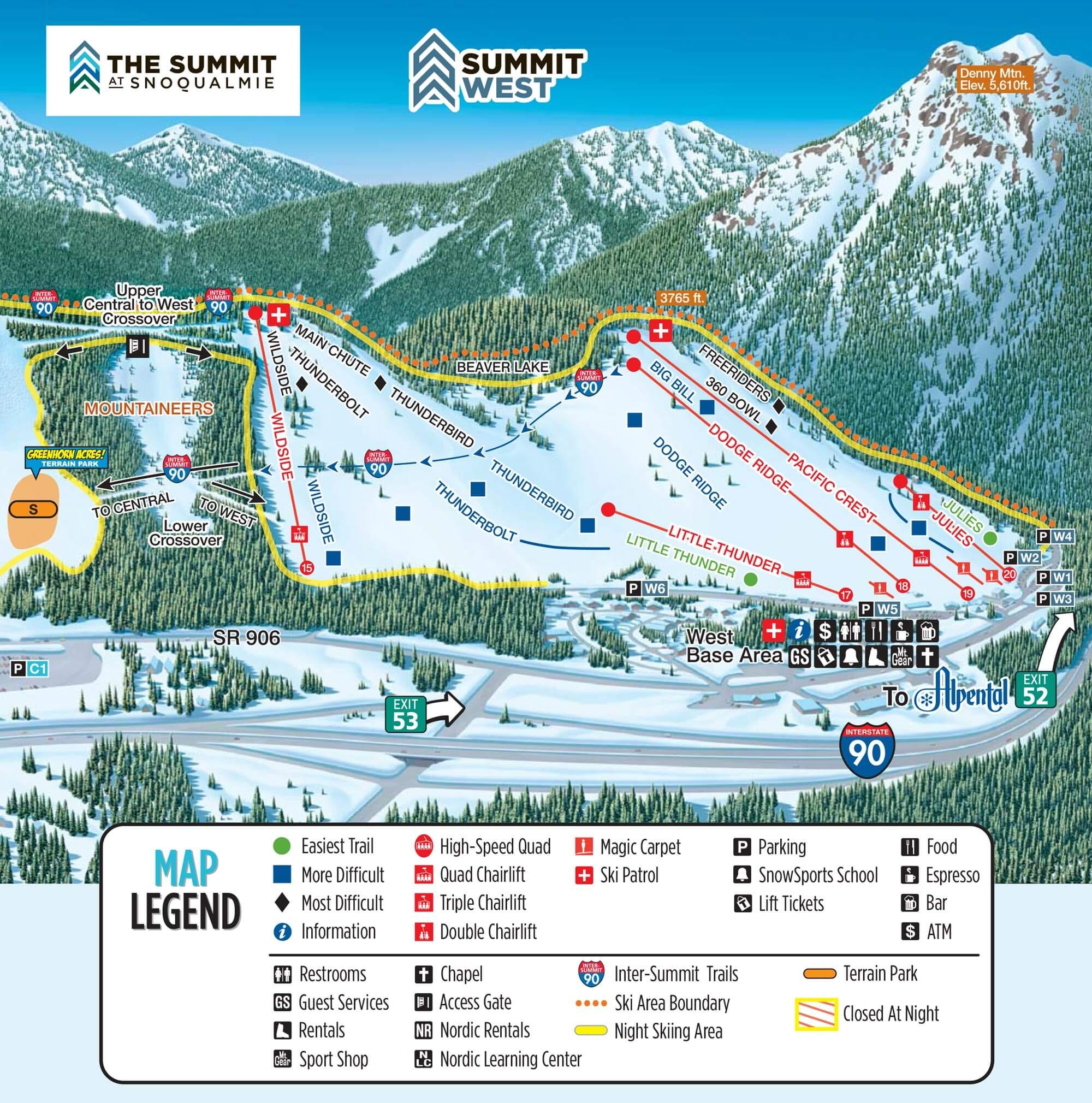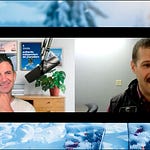NOTE: a few minutes ago, I published a comprehensive breakdown of Summit at Snoqualmie’s 2030 plan, which we discuss at length in this podcast. Click here to view that article, which includes detailed breakdowns of the plan, along with diagrams of the new lift alignments at each ski area.
Who
Guy Lawrence, President and General Manager of The Summit at Snoqualmie, Washington

Recorded on
April 18, 2022
About Summit at Snoqualmie
Click here for a mountain stats overview
Owned by: Boyne Resorts
Base elevation | summit elevation | vertical drop:
Alpental: 3,140 feet | 5,420 feet | 2,280 feet
Summit East: 2,610 feet | 3,710 feet | 1,100 feet
Summit Central: 2,840 feet | 3,865 feet | 1,025 feet
Summit West: 3,000 feet | 3,765 feet | 765 feet
Skiable Acres: 1,994 (600 acres of night skiing)
Alpental: 875 (including back bowls)
Summit East: 385 acres
Summit Central: 474 acres
Summit West: 260 acres
Average annual snowfall: 426 inches (varies by area)
Trail count: 150 (11% expert, 42% advanced, 33% intermediate, 14% beginner)
Terrain parks: 2
Lift count: 24 (3 high-speed quads, 4 fixed-grip quads, 3 triples, 9 doubles, 5 surface lifts - view Lift Blog’s inventory of The Summit at Snoqualmie’s lift fleet)
Trail maps:

Why I interviewed him
What is this wild place, four ski areas in one, scattered about the high ground like wintry little islands 50 miles east of the snowless coastal city? 400 inches of snow and no logic to it at all, dumping at 3,000 feet when the rain line is at 4,000, the Cascade Concrete of legend, except when it isn’t. The funny name and the funny trail map, the ski areas nothing like one another, as confusing a thing as there is in American skiing.
Boyne once owned two ski resorts in Washington. There was Crystal, and then there was this. Whatever this was. Maybe a feeder and maybe something else. And oh wait that’s where Alpental is? Why didn’t they just say that? Crystal is gone (it’s still there), but Boyne held onto this. And now we’re getting a real good sense of what this is.
I don’t know if it was the Ikon Pass or the runaway West Coast tech wealth or the Covid-driven outdoor explosion or the spread-the-word crowdsourcing supernova of social media, but suddenly Summit at Snoqualmie is One Of Those Places That We Talk About. Part of the overrun Washington trio that also includes Crystal and Stevens. The rest of the state’s ski areas are too remote to matter, at least for now, at least in that way. But these three have problems. Traffic problems and parking lot problems and liftline problems and terrain-management problems and, sometimes, too-much-snow-all-at-once problems. They’re all handling them different. Crystal has morphed from Ikon bottom-feeder to $1,699 season pass elitist with intricate parking-and-access policies in just two seasons. Stevens is hoping new management and a higher wage can offset the debilitating crowds driven by season passes that cost the same as one month of Netflix.
And Summit is doing what Boyne does: rethinking and rebuilding the resort to adapt to the modern ski experience. Washington State in 2022 is a tough place to make it as a ski resort, and I wanted to talk to the person in charge of Summit to understand exactly how they planned to do that.
What we talked about
The 2021-22 ski season; potential Summit closing dates; the T-bar ride that changed a life; Australia’s sprawling Perisher ski area; the majesty of European skiing; Vail Mountain; Badger Pass; Booth Creek; Summit and Washington in the homey ‘90s; when skier traffic started to explode; the founding of the four Summit at Snoqualmie ski areas and how they came together into the modern resort; why they’re bucketed as one ski area even though Alpental is separated by Interstate 90 and about two dozen cliff bands; why Summit East, Central, and West still have distinct trailmaps even though they are side by side; the varying personalities, schedules, and characteristics of each of Summit’s four ski areas; 400-plus inches of snow on the outskirts of a city that averages 4.6 inches per season; Summit at Snoqualmie’s 2030 plan; the logic of upgrading the Hidden Valley chair before the East Peak chair at Summit East; potential upgrades and re-alignments for Central Express; the new alignment and lift for Triple 60; why the old Gallery chair is likely to remain for the foreseeable future; thoughts on Easy Street and Reggie’s; the extent of the snowmaking system coming to Summit; the possibility of re-planting trees to introduce more defined trails around Summit; where’s the water going to come from?; the new lodge coming to Central; the Pacific Crest upgrade and the story behind the present lift; whether an upgraded Pacific Crest would make Dodge Ridge redundant; the upgrade and new alignment for Wildside; whether the areas between East, Central, and West could be developed with trails and lifts; the new International chair at Alpental; an upgrade and realignment for Sessel; the Edelweiss upgrade; why there won’t be an Armstrong upgrade just yet, and whether that could happen by 2030; and why Ikon Pass reservations are likely an indefinite fixture of the resort from now on.
Why I thought that now was a good time for this interview
This is the sixth 2030 plan that Boyne has released in the past two years, and together they tell a compelling story of a company angling to be the best in skiing. How’s that? All ski areas on public land – and that is most of them in the West – have master plans. Some, like Steamboat, even have branded Full Steam Ahead-style plans with videos and diagrams to teleport you into your white-laced future. But only Boyne is meticulously etching a story for each of its resorts, detailing the lifts, terrain expansions, and experiential razmataz that aims to make these properties the best in their respective regions.
Which takes us to Summit, perhaps Boyne’s most complicated resort. Take three Midwest-style ski areas, stacked side-by-side but built with vastly different philosophies and laced with lifts from at least eight different companies, many of which no longer exist. Then tack on a true big-mountain roustabout, but separate it from the rest with an interstate. Add 400-plus inches of heavy snow annually on avalanche-prone slopes, then drop the whole operation on the outskirts of a growing and ever-wealthier metropolitan population of 4 million. It’s not an easy place to imagine, let alone manage, and it was hard to say which direction Summit would carry this plan.

What they came up with is, I think, impressive: eight new or upgraded lifts, one of which will be a brand-new line up International. Every main lift except East Peak is slated for some sort of upgrade. Central will get top-to-bottom snowmaking and a new lodge. RFID is coming.
This is a lot to do in the next eight years, but it’s all worth doing, and it threads that impossible balance of uphill versus downhill capacity. Everyone hates crowds. Everyone hates crowded trails. Alpental’s Stone Age lift fleet wasn’t helping matters. Neither was the hodgepodge ascending the three-mile-wide sprawl at Summit. This plan rationalizes the whole operation, and hopefully tames some of the holiday and pow-day frustrations and lines.
There’s a lot of nuance to this plan, and a lot that could evolve as the years advance. I wanted to go deep on every detail, especially around the lift fleet, to give us the best possible understanding of this big, brash, and vital ski area.
Questions I wish I’d asked
Gosh, this was a long one. I had some questions loaded up about the switch to RFID, the mountain’s e-commerce upgrades, and parking lot upgrades (pavement!), and I suppose we could have discussed the summer ops a bit more, but we just ran out of time.
What I got wrong
I intimated that Summit at Snoqualmie had no existing snowmaking, but that is incorrect – they have a very rudimentary and limited existing system.
Why you should ski Summit at Snoqualmie
Because this is the template. There it is: the local bump. Night skiing six days a week. Swing through. Up and down 10 times and out. On weekends and vacations go elsewhere.
I’m aware that some of you live in ski towns, throw down a Ben Frank a year. Maybe more. And I’m glad that version of reality exists. But for those of us stuck in the in-between, quick hits are the way to rack numbers. And with multiple I-90 exit ramps almost directly into the parking lots, this is one of the most accessible ski areas in the country.
If Summit at Snoqualmie were just Summit East, Central, and West, that would be it, and that would be enough to keep the place busy and in business. But there’s also Alpental. And that… is a mountain. Enter: Boyne, the Ikon Pass, a rabid clique of PNW Backpack Bros hauling into the Bowls off International. All the cred sits on that little peak, more than double the height and size of its sisters, and 100 times rowdier. Me being me I would ski them all, titter-totter between, take pictures of the lifts and tweet upbound while gripping a Riblet centerpole. For the rest of you, you can probably just aim your GPS right to the base of Armstrong. Just remember your Ikon Pass reservation, your avy gear, and your free Back Bowls pass:
More Summit at Snoqualmie
How the four ski areas formed and came together (read more on Summit at Snoqualmie history):
A look at Alpental (read the ski area’s history from the point of view of founder James Griffin):
This is the 11th Storm Skiing Podcast with a Boyne executive. This is a company that knows what to do with the media. Here are the rest, in the order I recorded them:
Boyne Resorts CEO Stephen Kircher – Nov. 21, 2019
Loon Mountain GM Jay Scambio – Feb. 7, 2020
Sunday River President and GM Dana Bullen – Feb. 14, 2020
Boyne Resorts CEO Stephen Kircher – Covid edition – April 1, 2020 (no April Fool’s post that year)
Sugarloaf GM Karl Strand – Part 1 – Sept. 25, 2020
Sugarloaf GM Karl Strand – Part 2 – Sept. 30, 2020
Sunday River GM Brian Heon – Feb. 10, 2021
Boyne Mountain GM Ed Grice – Oct. 19, 2021
The Highlands at Harbor Springs President and GM Mike Chumbler – Feb. 18, 2022
Big Sky President and COO Taylor Middleton – April 6, 2022
And here are links to Boyne’s active long-term resort plans:
The Storm publishes year-round, and guarantees 100 articles per year. This is article 43/100 in 2022. Want to send feedback? Reply to this email and I will answer. You can also email skiing@substack.com.

















